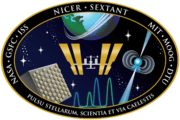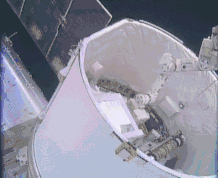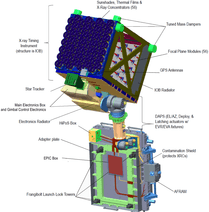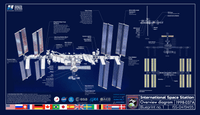Neutron Star Interior Composition Explorer
The Neutron star Interior Composition Explorer (NICER) is a NASA telescope on the International Space Station, designed and dedicated to the study of the extraordinary gravitational, electromagnetic, and nuclear physics environments embodied by neutron stars, exploring the exotic states of matter where density and pressure are higher than in atomic nuclei. As part of NASA's Explorers program, NICER enabled rotation-resolved spectroscopy of the thermal and non-thermal emissions of neutron stars in the soft (0.2–12 keV) X-ray band with unprecedented sensitivity, probing interior structure, the origins of dynamic phenomena, and the mechanisms that underlie the most powerful cosmic particle accelerators known.[4] NICER achieved these goals by deploying, following the launch, and activation of X-ray timing and spectroscopy instruments. NICER was selected by NASA to proceed to formulation phase in April 2013.[5]
 NICER telescope mounted on the Integrated Truss Structure of the International Space Station | |
| Mission type | Neutron star astrophysics |
|---|---|
| Operator | NASA / GSFC / MIT |
| Website | https://heasarc.gsfc.nasa.gov/docs/nicer/ |
| Mission duration | Planned: 18 months |
| Spacecraft properties | |
| Launch mass | 372 kg (820 lb)[1] |
| Start of mission | |
| Launch date | 3 June 2017, 21:07:38 UTC[2] |
| Rocket | Falcon 9 Full Thrust |
| Launch site | Kennedy LC-39A |
| Contractor | SpaceX |
| Orbital parameters | |
| Reference system | Geocentric |
| Regime | Low Earth |
| Eccentricity | 0.0003086 |
| Perigee altitude | 402 km (250 mi) AMSL[3] |
| Apogee altitude | 407 km (253 mi) AMSL[3] |
| Inclination | 51.64 degrees[3] |
| Period | 92.66 minutes[3] |
| Mean motion | 15.54[3] |
| Epoch | 21 February 2018, 12:32:45 UTC[3] |
| Instruments | |
| X-ray Timing Instrument (XTI) | |
 NICER / SEXTANT mission patch | |
NICER-SEXTANT uses the same instrument to test X-ray timing for positioning and navigation,[6] and MXS is a test of X-ray timing communication.[7] In January 2018, X-ray navigation was demonstrated using NICER on ISS.[8]
Launch
By May 2015, NICER was on track for a 2016 launch, having passed its critical design review and resolved an issue with the power being supplied by the ISS.[9] Following the CRS-7 loss in June 2015, which delayed future missions by several months, NICER was finally launched on 3 June 2017,[2] with the SpaceX CRS-11 ISS resupply mission aboard a Falcon 9 v1.2 rocket.[10]
Science instrument
NICER's primary science instrument, called the X-ray Timing Instrument (XTI), is an array of 56 X-ray photon detectors. These detectors record the energies of the collected photons as well as with their time of arrival. A GPS receiver enables accurate timing and positioning measurements. X-ray photons can be time-tagged with a precision of less than 300 nsec.[11]
During each ISS orbit, NICER will observe two to four targets. Gimbaling and a star tracker allow NICER to track specific targets while collecting science data. In order to achieve its science objectives, NICER will take over 15 million seconds of exposures over an 18-month period.[12]
X-ray navigation and communication experiments
An enhancement to the NICER mission, the Station Explorer for X-ray Timing and Navigation Technology (SEXTANT), will act as a technology demonstrator for X-ray pulsar-based navigation (XNAV) techniques that may one day be used for deep-space navigation.[13]
XCOM
As part of NICER testing, a rapid-modulation X-ray device was developed called Modulated X-ray Source (MXS), which is being used to create an X-ray communication system (XCOM) demonstration. If approved and installed on the ISS, XCOM will transmit data encoded into X-ray bursts to the NICER platform, which may lead to the development of technologies that allow for gigabit bandwidth communication throughout the Solar System.[7] As of February 2019 the XCOM test is scheduled for spring 2019.[14] XCOM (inc MXS) was delivered to the ISS in May 2019.[15]
Selected results
In May 2018, NICER discovered an X-ray pulsar in the fastest stellar orbit yet discovered.[16] The pulsar and its companion star were found to orbit each other every 38 minutes.[16]
On 21 August 2019 (UTC; 20 August in the US), NICER spotted the brightest X-ray burst so far observed.[17] It came from the neutron star SAX J1808.4−3658 about 11,000 light-years from Earth in the constellation Sagittarius.
See also
- Chandra X-ray Observatory, NASA's flagship space observatory for X-rays, in orbit since 1999
- List of X-ray space telescopes
- NuSTAR, NASA Explorer-class hard X-ray space observatory, in orbit since 2012
- Rossi X-ray Timing Explorer, an X-ray timing space observatory, active 1995–2012
- X-ray telescope
- XMM-Newton, ESA X-ray space observatory, in orbit since 1999
References
![]()
- "SpaceX CRS-11 Mission Overview" (PDF). NASA. Retrieved 3 June 2017.
- Clark, Stephen (3 June 2017). "Reused Dragon cargo capsule launched on journey to space station". Spaceflight Now. Retrieved 3 June 2017.
- Peat, Chris (21 February 2018). "ISS – Orbit". Heavens-above.com. Retrieved 21 February 2018.
- Gendreau, Keith C.; Arzoumanian, Zaven; Okajima, Takashi (September 2012). "The Neutron star Interior Composition ExploreR (NICER): an Explorer mission of opportunity for soft x-ray timing spectroscopy" (PDF). Proceedings of the SPIE: Space Telescopes and Instrumentation 2012, Ultraviolet to Gamma Ray. Space Telescopes and Instrumentation 2012: Ultraviolet to Gamma Ray. 8443: 844313. Bibcode:2012SPIE.8443E..13G. doi:10.1117/12.926396.
- Harrington, J. D. (5 April 2013). "NASA Selects Explorer Investigations for Formulation" (Press release). NASA. Retrieved 23 April 2013.
- Garner, Rob (17 July 2017). "NASA Neutron Star Mission Begins Science Operations". NASA. Retrieved 26 January 2018.
- Keesey, Lori (4 November 2016). "NASA's NavCube Could Support an X-ray Communications Demonstration in Space — A NASA First". NASA. Retrieved 5 November 2016.
- "ISS Utilization: NICER/SEXTANT". eoPortal. European Space Agency.
- Keesey, Lori (12 May 2015). "NASA's Multi-Purpose NICER/SEXTANT Mission on Track for 2016 Launch". NASA. Retrieved 27 October 2015.
- "NICER Manifested on SpaceX-11 ISS Resupply Flight". NICER News. NASA. 1 December 2015. Retrieved 14 June 2017.
Previously scheduled for a December 2016 launch on SpaceX-12, NICER will now fly to the International Space Station with two other payloads on SpaceX Commercial Resupply Services (CRS)-11, in the Dragon vehicle's unpressurized Trunk.
- Gendreau; et al. (2012). "The Neutron star Interior Composition ExploreR (NICER): an Explorer mission of opportunity for soft x-ray timing spectroscopy" (PDF).
Each photon detected by NICER is time-tagged with an absolute precision of much better than 300 nsec
Explicit use of et al. in:|author=(help) - "NICER: Neutron star Interior Composition Explorer" (PDF). NASAFacts. NASA. Retrieved 14 June 2017.
- Mitchell, Jason W.; Hassouneh, Munther A.; Winternitz, Luke M. B.; Valdez, Jennifer E.; Price, Samuel R.; et al. (January 2015). SEXTANT - Station Explorer for X-ray Timing and Navigation Technology (PDF). AIAA Guidance, Navigation, and Control Conference. 5–9 January 2015. Kissimmee, Florida. GSFC-E-DAA-TN19095; 20150001327.
- NASA set to demonstrate X-ray communications in space Feb 2019
- X-ray communications experiment delivered to space station May 2019
- Garner, Rob (10 May 2018). "X-ray Pulsar Found in Record-fast Orbit". NASA. Retrieved 12 May 2018.
- NICER Telescope Spots Brightest X-Ray Burst Ever Observed
External links
![]()
- NICER website by NASA's Goddard Space Flight Center
- NICER website at NASA.gov
- NICER installation animations and videos
.jpg)

_-_34718447596.jpg)


.png)